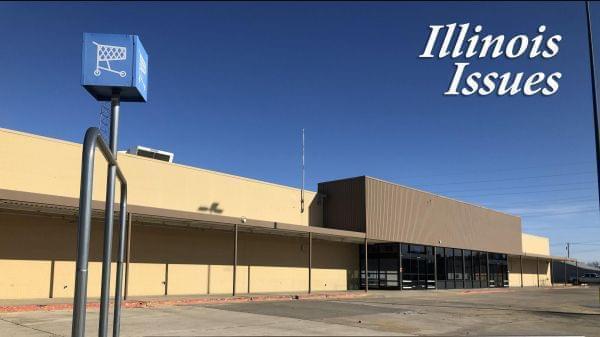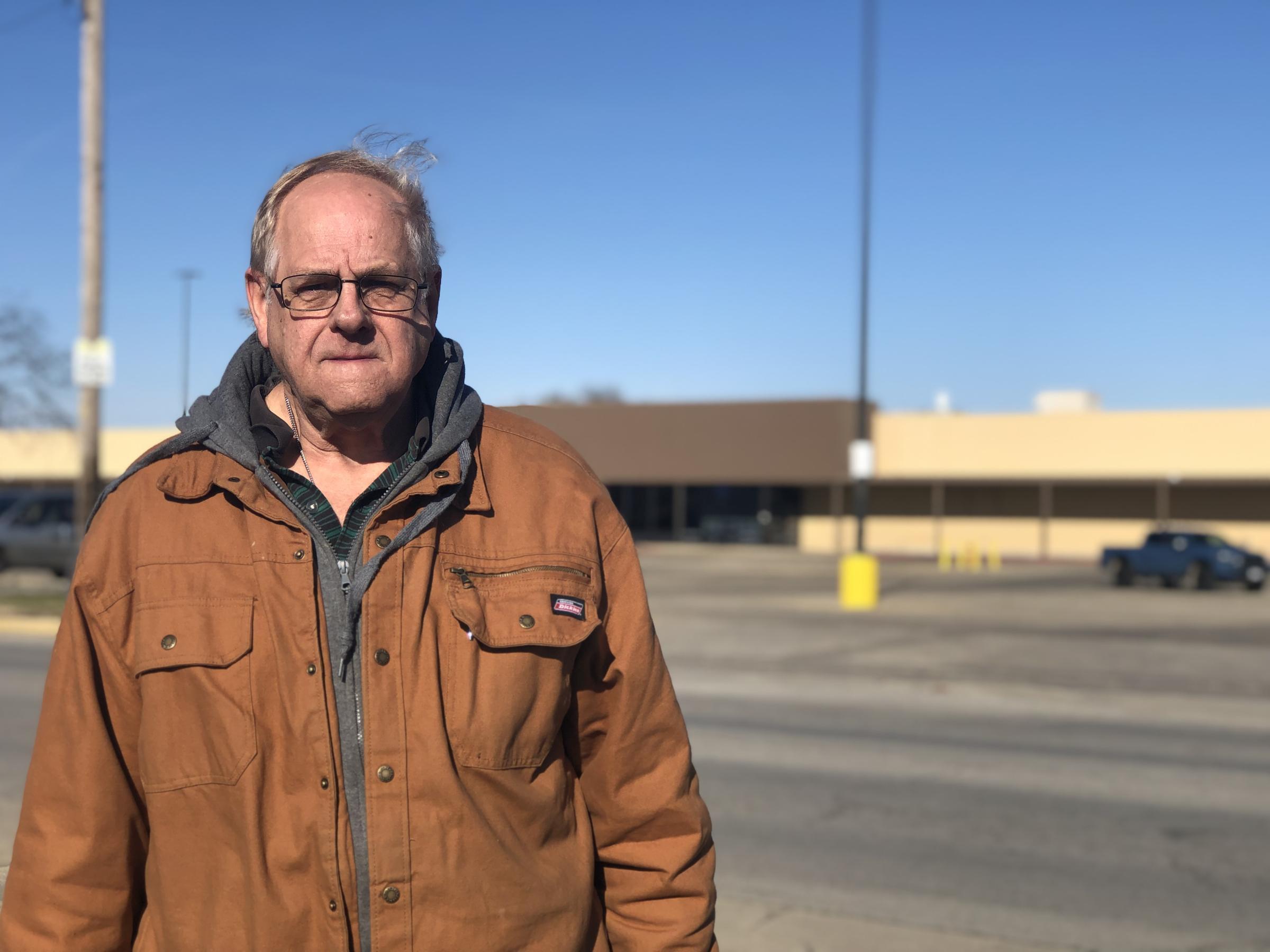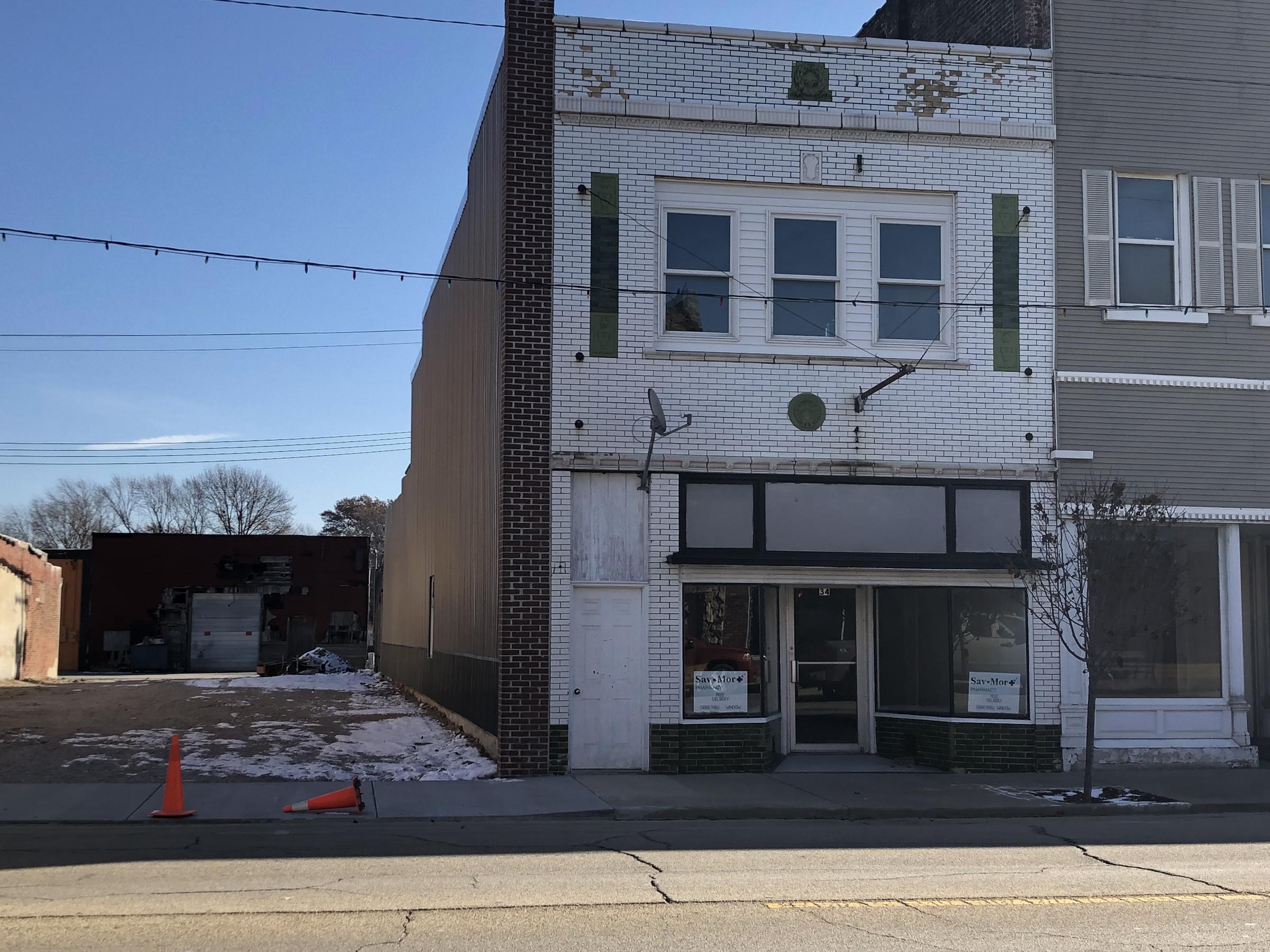Illinois Issues: When Walmart Leaves Town

The now vacant Walmart lot in Pana, Illinois. December 2018. Daisy Contreras/NPR Illinois
On a sunny, cold day in December, 73-year-old Glenn Schneider tours downtown Pana in central Illinois. He’s walking toward an empty parking lot, where a large, vacant building now stands.
A year ago, there would have probably been at least 50 cars in that parking lot,” he said.
The building once housed a Walmart, where Schneider worked maintenance for 17 years. Pana is located about 40 miles south of Springfield--and was once a bustling community.
A century ago it had large coal-powered greenhouses growing roses—serving as a distribution center for the rest of the country. That’s how it got the name ‘City of Roses’. But the town has since gone through many changes: the greenhouses shut down and the coal mines closed. The 2010 Census estimated the town has a population of 5,700.
And two months ago -- the town took another blow after their 35-year-old Walmart store closed its doors.
Schneider said the town is still dealing with the aftermath. “[The Walmart] was just so handy. You could go there. You could buy nuts, bolts, tape and school supplies.”

Glenn Schnider is a former Walmart employee. He worked at the Pana location for 17 years.
Pana was not alone. A Walmart in Clinton -- another town in central Illinois between Decatur and Bloomington -- also suffered the same fate over the summer. Clinton had the smallest Walmart store in the state.
Experts say the retail closures are only a symptom of bigger issues taking place in the rural Midwest: declining population, aging baby-boomers and rising poverty rates.
Some local town officials, however, see the closures as an opportunity to revitalize their small cities and wean residents off Walmart convenience.
When the Walmart moved into Pana in 1983, local businesses could not compete with the lower prices offered by the large retail store. One glaring example: Pana had three independently-owned pharmacies in the ’80s, but those were forced to close.
Chris Merrett, director of the Illinois Institute for Rural Affairs at Western Illinois University said Walmart coming in changed these small towns and their main street landscapes.
“And so when these Walmarts close shop, there is really a void because many of those mom and pop shops that were there 40 and 50 years ago are no longer there. Walmart leaves and so there is this emptiness, this empty retail space,” he said.
Walmart issued a statement that said employees at its Pana store would be given the opportunity to relocate to nearby stores.
Pana’s mayor, Donald Kroski said Walmart’s decision was abrupt, with only a month’s notice.
“The reason they gave me on a phone call was, this store did not fit the image of the future Walmarts.”
Merrett said he believes retail closures will continue especially if small, rural towns can’t keep up with the online shopping trends forcing brick and mortar stores to re-evaluate their business strategies. Most, if not all, are competing with Amazon’s lucrative model.
The state needs to tackle issues of population loss and aging residents who have less money to spend after retirement, he said. “It sounds like it's a big, lofty discussion far field from Walmart, but the issue of small town Walmarts closing is a symptom of a deeper demographic problem in downstate Illinois.”
Walmart did not respond to a request for comment on whether they had future plans to close more stores in rural communities.
But Pana’s Mayor said without Walmart as a competitor this could be an opportunity for his town to return to more independently-owned businesses.
David Falk also saw that opportunity. His family operated a Sav Mor pharmacy in town for years. He’s made a proposal to reopen the family business.

The new location for the Sav Mor pharmacy in Pana. Thirty-five years ago the pharmacy closed when the Walmart came into town. The owner, David Faulk, says he saw Walmart's exit as an opportunity to return.
“When Walmart came to town, it was too many pharmacies in a small town, and we just couldn’t make it. So we closed up shop and left,” he said. Pana currently has a Walgreens that has tried handling the load of prescriptions Walmart left behind. Faulk said his pharmacy could offer extra help.
“Pana was good to us when we were there before, so we thought we’d come back and try again.”
Merrett, who studies rural issues, is not as optimistic about a resurgence for small business. He says that also holds true for the Dollar General stores, which Mayor Kroski says will have the opportunity to expand by offering a wider selection of items.
“There will come a point where even Dollar General will retreat. So the question of retail on main street, rural Illinois is a question about retail trade in the general sense, but also about demographics.”
Back in Pana, the looming Walmart sign is gone and the building remains empty.

Glenn Schneider, the former Walmart maintenance worker who also serves as a Pana alderman, says he’ll be pushing to help revitalize downtown. And he has a suggestion for Walmart when it comes to making decisions for other places:
“Talk to the community, get their input, not just in the boardroom,” he said.
“If they’ve got a store that’s losing money, well they need to figure out what they can do, what the community can do.”
Links
- Illinois Issues: Ten Years Later, Has Illinois Learned The Right Lessons From Blagojevich?
- Illinois Issues: Illinois’ Birth - We Cooked The Books
- Illinois Issues: Gov. Rauner And The Folly Of Hubris
- Illinois Issues: Why Is Deerfield (Still) So White?
- Illinois Issues: Dear Governor-Elect Pritzker
- Illinois Issues: Third Parties - If Not Now, When?
- Illinois Issues: For Illinois Governors, Political Experience Optional
- Illinois Issues: The People Spoke—And We Listened
- Illinois Issues: Comptroller, Treasurer - The Story Of How One Office Became Two
- Illinois Issues: Is Age Just A Number? The Race For Illinois Secretary Of State
- Illinois Issues: Budget Suggestions For The Winning Candidate For Governor
- Illinois Issues: The Janus Effect - Will African-American Women Pay?
